The Significance of Maori Proverbs: Culture, Wisdom, and Health Today
VerifiedAdded on 2023/04/08
|5
|864
|79
Essay
AI Summary
This essay explores the significance of Maori proverbs (Whakatauki) within Maori culture, highlighting their role in conveying wisdom, cultural values, and life lessons. It focuses on two proverbs: 'Tama tu tama ora, tama noho tama mate,' which emphasizes the importance of physical activity for health, and 'E hoa ma, ina te ora o te tangata,' which celebrates the cultural unity and hospitality associated with sharing meals. The essay argues that these proverbs remain relevant today, with the former addressing the rise of lifestyle diseases and the latter emphasizing the importance of social connection and cultural preservation through shared food experiences. It concludes that Whakatauki effectively communicates cultural traditions and encourages positive lifestyle choices.
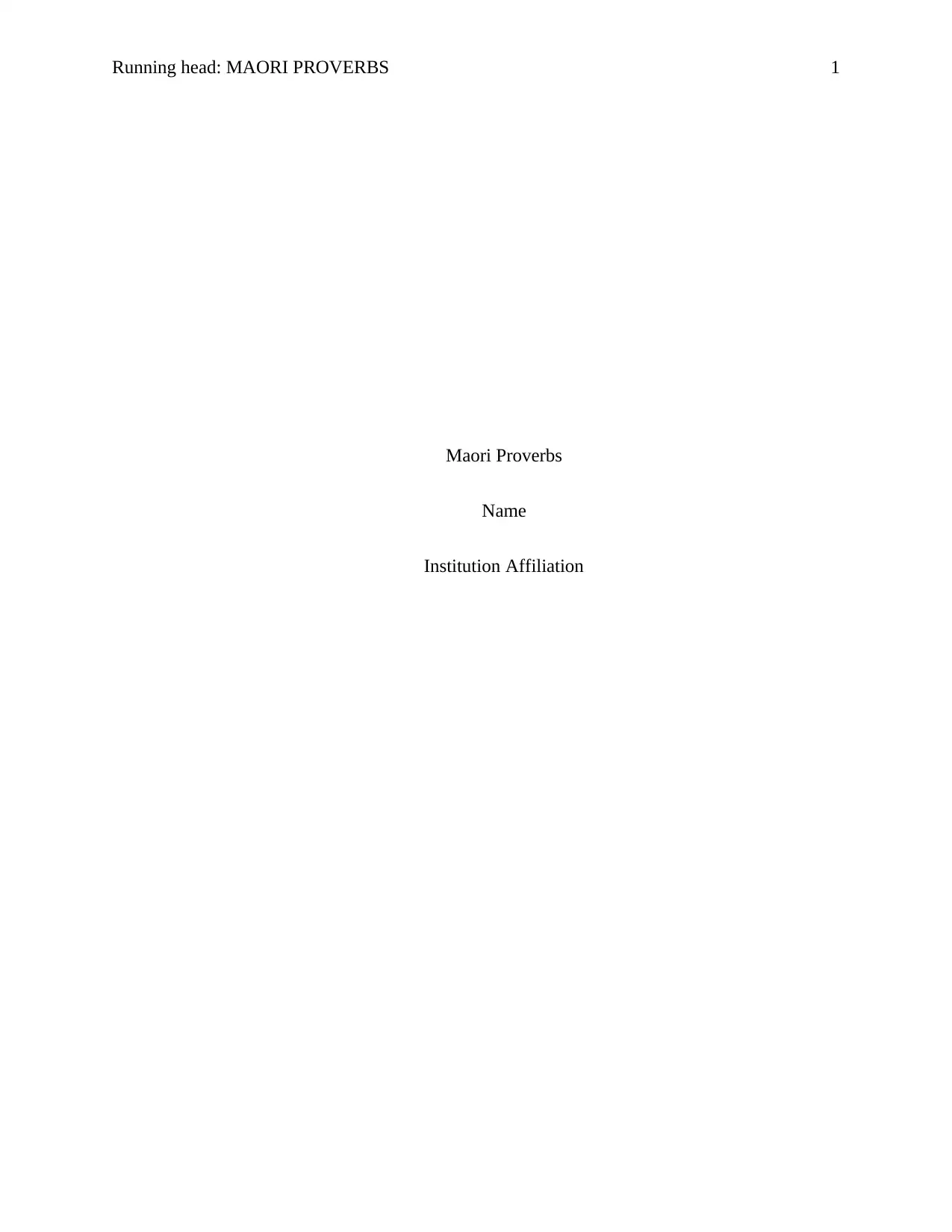
Running head: MAORI PROVERBS 1
Maori Proverbs
Name
Institution Affiliation
Maori Proverbs
Name
Institution Affiliation
Paraphrase This Document
Need a fresh take? Get an instant paraphrase of this document with our AI Paraphraser
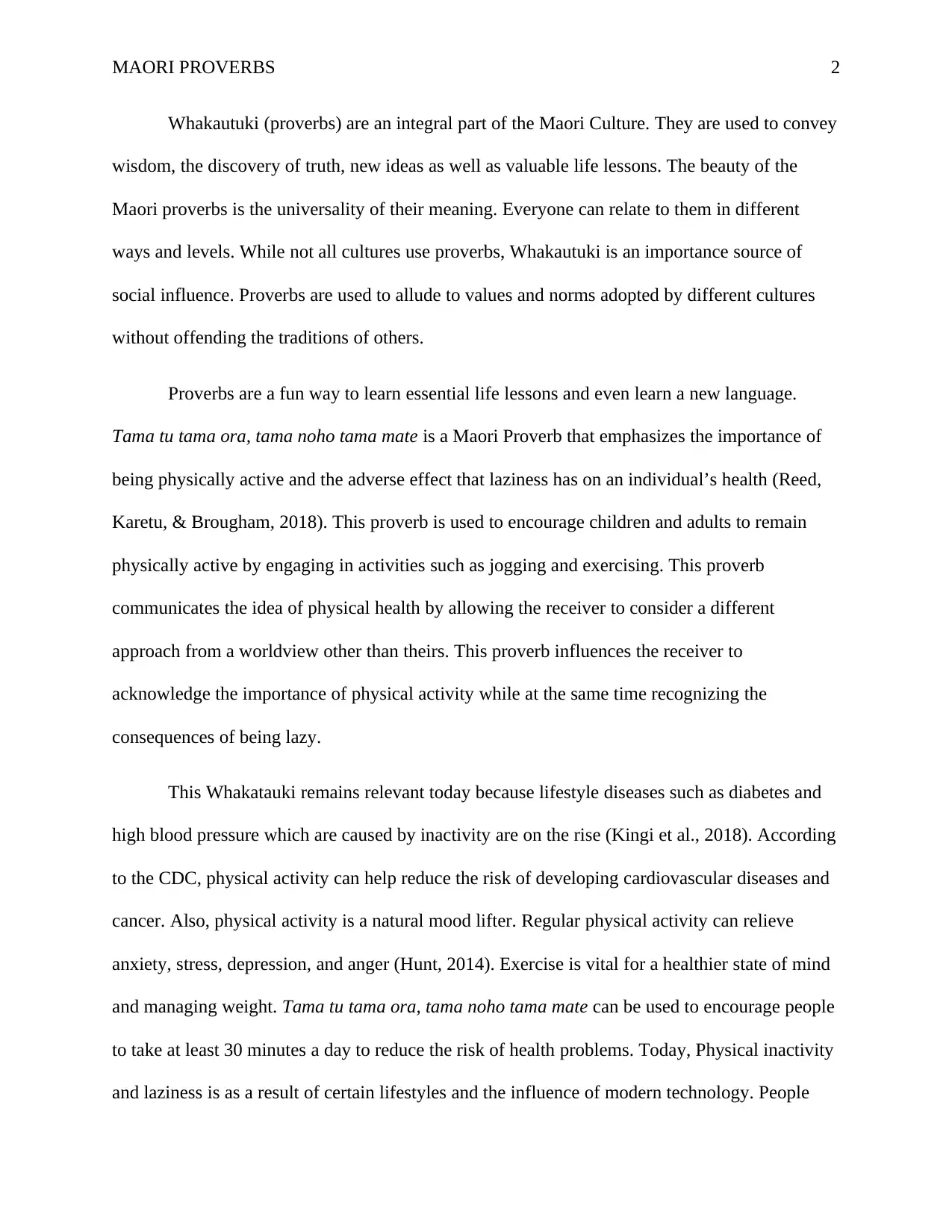
MAORI PROVERBS 2
Whakautuki (proverbs) are an integral part of the Maori Culture. They are used to convey
wisdom, the discovery of truth, new ideas as well as valuable life lessons. The beauty of the
Maori proverbs is the universality of their meaning. Everyone can relate to them in different
ways and levels. While not all cultures use proverbs, Whakautuki is an importance source of
social influence. Proverbs are used to allude to values and norms adopted by different cultures
without offending the traditions of others.
Proverbs are a fun way to learn essential life lessons and even learn a new language.
Tama tu tama ora, tama noho tama mate is a Maori Proverb that emphasizes the importance of
being physically active and the adverse effect that laziness has on an individual’s health (Reed,
Karetu, & Brougham, 2018). This proverb is used to encourage children and adults to remain
physically active by engaging in activities such as jogging and exercising. This proverb
communicates the idea of physical health by allowing the receiver to consider a different
approach from a worldview other than theirs. This proverb influences the receiver to
acknowledge the importance of physical activity while at the same time recognizing the
consequences of being lazy.
This Whakatauki remains relevant today because lifestyle diseases such as diabetes and
high blood pressure which are caused by inactivity are on the rise (Kingi et al., 2018). According
to the CDC, physical activity can help reduce the risk of developing cardiovascular diseases and
cancer. Also, physical activity is a natural mood lifter. Regular physical activity can relieve
anxiety, stress, depression, and anger (Hunt, 2014). Exercise is vital for a healthier state of mind
and managing weight. Tama tu tama ora, tama noho tama mate can be used to encourage people
to take at least 30 minutes a day to reduce the risk of health problems. Today, Physical inactivity
and laziness is as a result of certain lifestyles and the influence of modern technology. People
Whakautuki (proverbs) are an integral part of the Maori Culture. They are used to convey
wisdom, the discovery of truth, new ideas as well as valuable life lessons. The beauty of the
Maori proverbs is the universality of their meaning. Everyone can relate to them in different
ways and levels. While not all cultures use proverbs, Whakautuki is an importance source of
social influence. Proverbs are used to allude to values and norms adopted by different cultures
without offending the traditions of others.
Proverbs are a fun way to learn essential life lessons and even learn a new language.
Tama tu tama ora, tama noho tama mate is a Maori Proverb that emphasizes the importance of
being physically active and the adverse effect that laziness has on an individual’s health (Reed,
Karetu, & Brougham, 2018). This proverb is used to encourage children and adults to remain
physically active by engaging in activities such as jogging and exercising. This proverb
communicates the idea of physical health by allowing the receiver to consider a different
approach from a worldview other than theirs. This proverb influences the receiver to
acknowledge the importance of physical activity while at the same time recognizing the
consequences of being lazy.
This Whakatauki remains relevant today because lifestyle diseases such as diabetes and
high blood pressure which are caused by inactivity are on the rise (Kingi et al., 2018). According
to the CDC, physical activity can help reduce the risk of developing cardiovascular diseases and
cancer. Also, physical activity is a natural mood lifter. Regular physical activity can relieve
anxiety, stress, depression, and anger (Hunt, 2014). Exercise is vital for a healthier state of mind
and managing weight. Tama tu tama ora, tama noho tama mate can be used to encourage people
to take at least 30 minutes a day to reduce the risk of health problems. Today, Physical inactivity
and laziness is as a result of certain lifestyles and the influence of modern technology. People
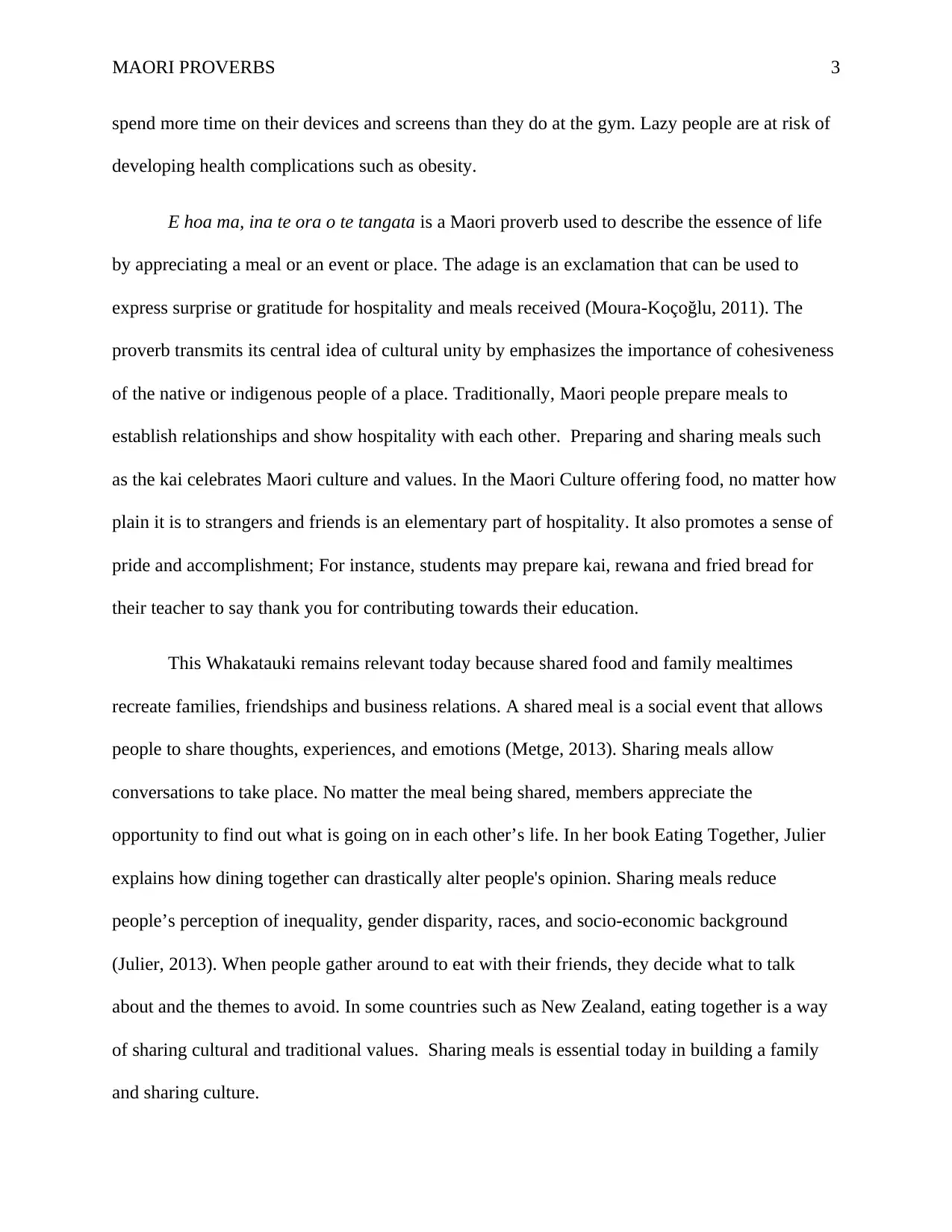
MAORI PROVERBS 3
spend more time on their devices and screens than they do at the gym. Lazy people are at risk of
developing health complications such as obesity.
E hoa ma, ina te ora o te tangata is a Maori proverb used to describe the essence of life
by appreciating a meal or an event or place. The adage is an exclamation that can be used to
express surprise or gratitude for hospitality and meals received (Moura-Koçoğlu, 2011). The
proverb transmits its central idea of cultural unity by emphasizes the importance of cohesiveness
of the native or indigenous people of a place. Traditionally, Maori people prepare meals to
establish relationships and show hospitality with each other. Preparing and sharing meals such
as the kai celebrates Maori culture and values. In the Maori Culture offering food, no matter how
plain it is to strangers and friends is an elementary part of hospitality. It also promotes a sense of
pride and accomplishment; For instance, students may prepare kai, rewana and fried bread for
their teacher to say thank you for contributing towards their education.
This Whakatauki remains relevant today because shared food and family mealtimes
recreate families, friendships and business relations. A shared meal is a social event that allows
people to share thoughts, experiences, and emotions (Metge, 2013). Sharing meals allow
conversations to take place. No matter the meal being shared, members appreciate the
opportunity to find out what is going on in each other’s life. In her book Eating Together, Julier
explains how dining together can drastically alter people's opinion. Sharing meals reduce
people’s perception of inequality, gender disparity, races, and socio-economic background
(Julier, 2013). When people gather around to eat with their friends, they decide what to talk
about and the themes to avoid. In some countries such as New Zealand, eating together is a way
of sharing cultural and traditional values. Sharing meals is essential today in building a family
and sharing culture.
spend more time on their devices and screens than they do at the gym. Lazy people are at risk of
developing health complications such as obesity.
E hoa ma, ina te ora o te tangata is a Maori proverb used to describe the essence of life
by appreciating a meal or an event or place. The adage is an exclamation that can be used to
express surprise or gratitude for hospitality and meals received (Moura-Koçoğlu, 2011). The
proverb transmits its central idea of cultural unity by emphasizes the importance of cohesiveness
of the native or indigenous people of a place. Traditionally, Maori people prepare meals to
establish relationships and show hospitality with each other. Preparing and sharing meals such
as the kai celebrates Maori culture and values. In the Maori Culture offering food, no matter how
plain it is to strangers and friends is an elementary part of hospitality. It also promotes a sense of
pride and accomplishment; For instance, students may prepare kai, rewana and fried bread for
their teacher to say thank you for contributing towards their education.
This Whakatauki remains relevant today because shared food and family mealtimes
recreate families, friendships and business relations. A shared meal is a social event that allows
people to share thoughts, experiences, and emotions (Metge, 2013). Sharing meals allow
conversations to take place. No matter the meal being shared, members appreciate the
opportunity to find out what is going on in each other’s life. In her book Eating Together, Julier
explains how dining together can drastically alter people's opinion. Sharing meals reduce
people’s perception of inequality, gender disparity, races, and socio-economic background
(Julier, 2013). When people gather around to eat with their friends, they decide what to talk
about and the themes to avoid. In some countries such as New Zealand, eating together is a way
of sharing cultural and traditional values. Sharing meals is essential today in building a family
and sharing culture.
⊘ This is a preview!⊘
Do you want full access?
Subscribe today to unlock all pages.

Trusted by 1+ million students worldwide
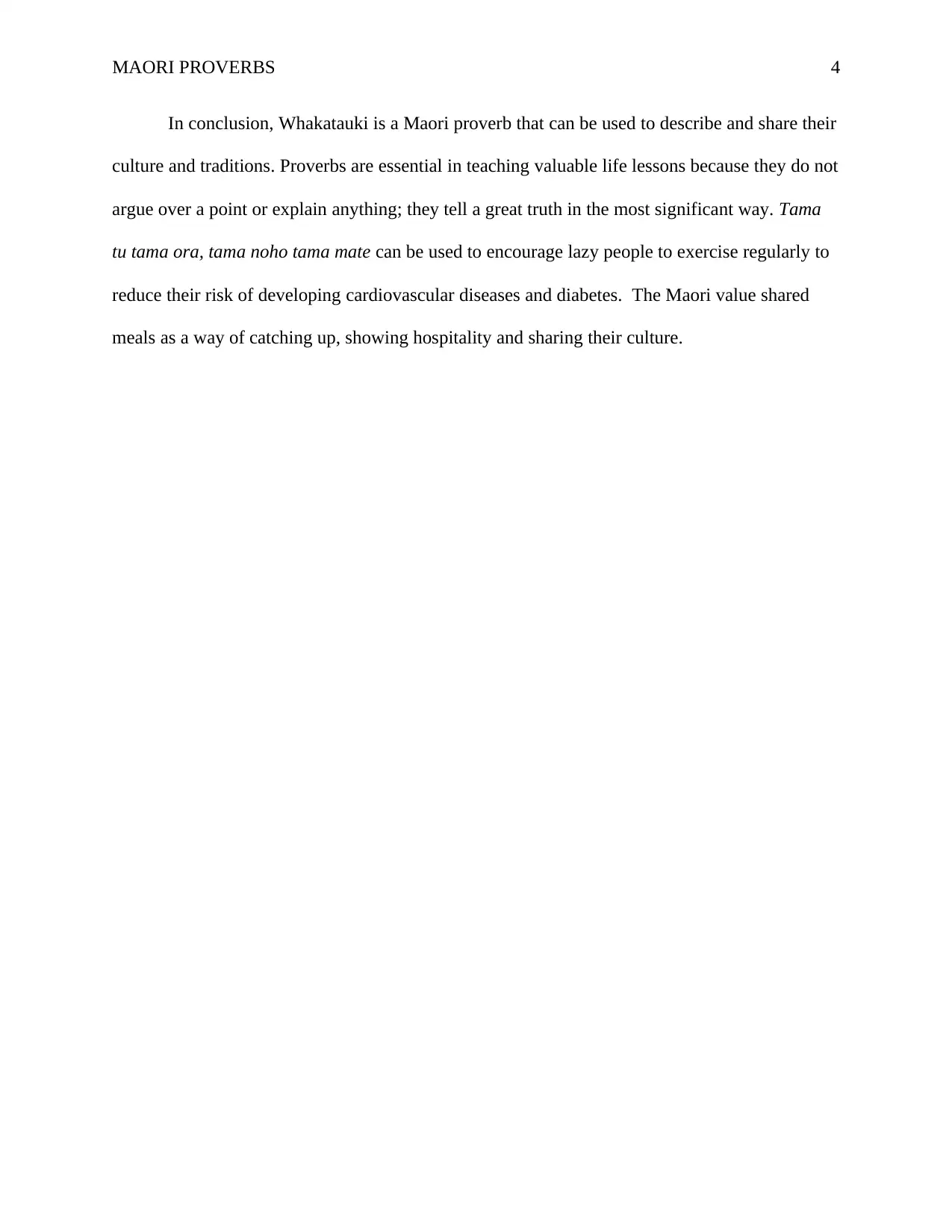
MAORI PROVERBS 4
In conclusion, Whakatauki is a Maori proverb that can be used to describe and share their
culture and traditions. Proverbs are essential in teaching valuable life lessons because they do not
argue over a point or explain anything; they tell a great truth in the most significant way. Tama
tu tama ora, tama noho tama mate can be used to encourage lazy people to exercise regularly to
reduce their risk of developing cardiovascular diseases and diabetes. The Maori value shared
meals as a way of catching up, showing hospitality and sharing their culture.
In conclusion, Whakatauki is a Maori proverb that can be used to describe and share their
culture and traditions. Proverbs are essential in teaching valuable life lessons because they do not
argue over a point or explain anything; they tell a great truth in the most significant way. Tama
tu tama ora, tama noho tama mate can be used to encourage lazy people to exercise regularly to
reduce their risk of developing cardiovascular diseases and diabetes. The Maori value shared
meals as a way of catching up, showing hospitality and sharing their culture.
Paraphrase This Document
Need a fresh take? Get an instant paraphrase of this document with our AI Paraphraser
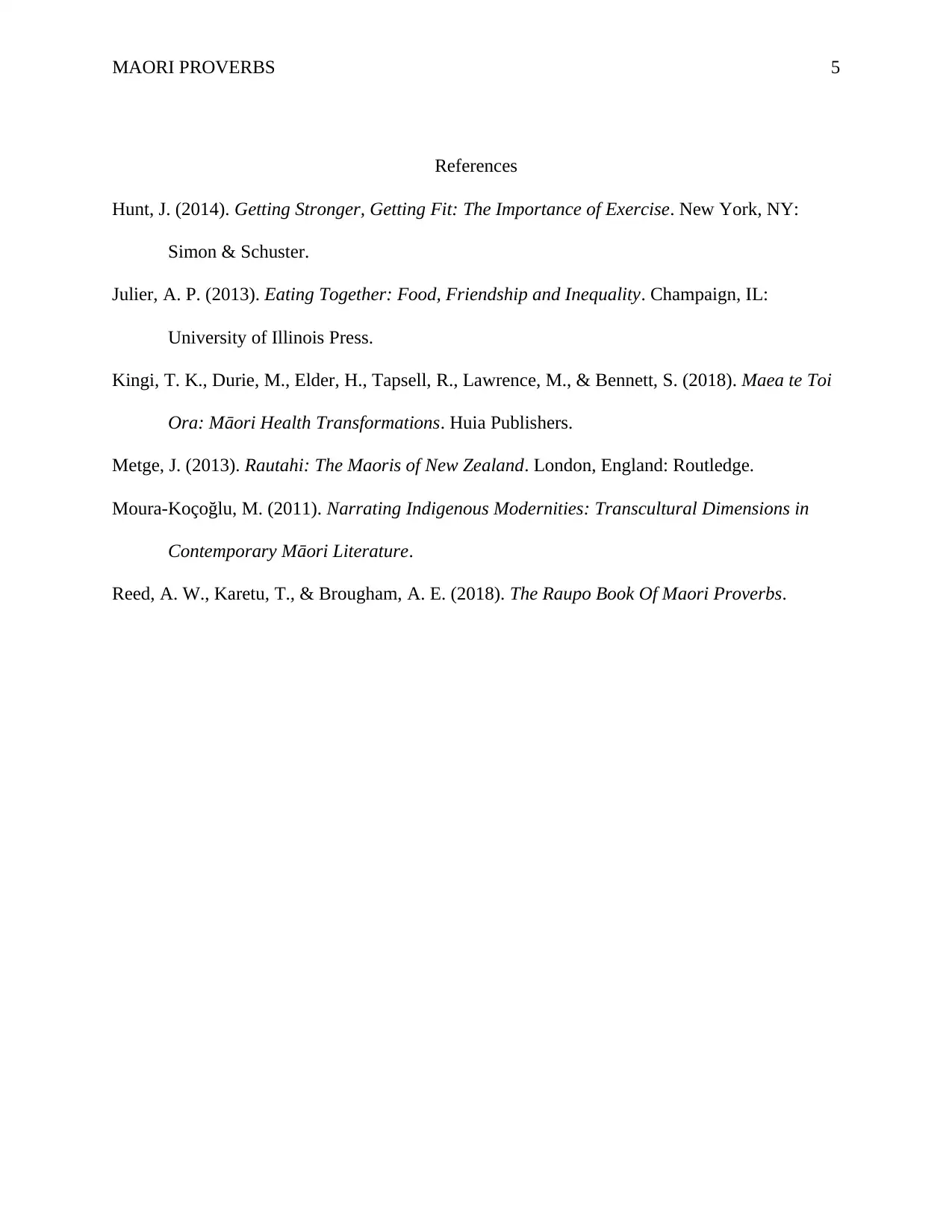
MAORI PROVERBS 5
References
Hunt, J. (2014). Getting Stronger, Getting Fit: The Importance of Exercise. New York, NY:
Simon & Schuster.
Julier, A. P. (2013). Eating Together: Food, Friendship and Inequality. Champaign, IL:
University of Illinois Press.
Kingi, T. K., Durie, M., Elder, H., Tapsell, R., Lawrence, M., & Bennett, S. (2018). Maea te Toi
Ora: Māori Health Transformations. Huia Publishers.
Metge, J. (2013). Rautahi: The Maoris of New Zealand. London, England: Routledge.
Moura-Koçoğlu, M. (2011). Narrating Indigenous Modernities: Transcultural Dimensions in
Contemporary Māori Literature.
Reed, A. W., Karetu, T., & Brougham, A. E. (2018). The Raupo Book Of Maori Proverbs.
References
Hunt, J. (2014). Getting Stronger, Getting Fit: The Importance of Exercise. New York, NY:
Simon & Schuster.
Julier, A. P. (2013). Eating Together: Food, Friendship and Inequality. Champaign, IL:
University of Illinois Press.
Kingi, T. K., Durie, M., Elder, H., Tapsell, R., Lawrence, M., & Bennett, S. (2018). Maea te Toi
Ora: Māori Health Transformations. Huia Publishers.
Metge, J. (2013). Rautahi: The Maoris of New Zealand. London, England: Routledge.
Moura-Koçoğlu, M. (2011). Narrating Indigenous Modernities: Transcultural Dimensions in
Contemporary Māori Literature.
Reed, A. W., Karetu, T., & Brougham, A. E. (2018). The Raupo Book Of Maori Proverbs.
1 out of 5
Related Documents
Your All-in-One AI-Powered Toolkit for Academic Success.
+13062052269
info@desklib.com
Available 24*7 on WhatsApp / Email
![[object Object]](/_next/static/media/star-bottom.7253800d.svg)
Unlock your academic potential
Copyright © 2020–2025 A2Z Services. All Rights Reserved. Developed and managed by ZUCOL.



